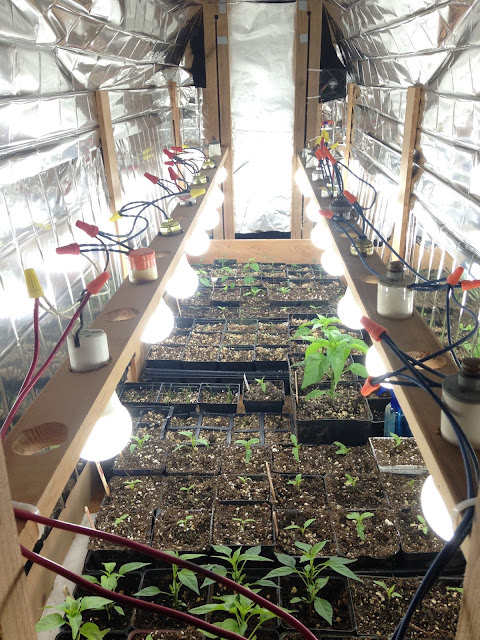Now, in early April, the vegetable gardens in the Pacific Northwest are coming to life. My peas are a few inches tall and starting to climb their trellises. Fruit trees are budding, rhubarb is sprouting, and salad greens that were started in greenhouses and cold frames are ready to be planted outside. This is the end of "the hungry stretch" - the months in late Winter and early Spring when supplies of squash, potatoes and canned harvests from the Fall are running low, but the new Spring growth hasn't produced much besides the occasional salad garnish. Now it is time to hunt slugs, prepare beds, and select the most promising starts to be transplanted.
Below: mustard greens from a variety mix
Below: lettuce starts from seed saved from last years mix
Below: trays of starts in the greenhouse
Here is the Pacific Northwest our long, cool spring is fantastic for salad and peas, but we have to plan ahead for good yields in Summer gardens. The most needy vegetables are the Solanum family - tomatoes, tomatillos, eggplants, and peppers. In the Pacific Northwest we need to start our Solanums early. This year I started peppers in January and tomatoes in March.
I decided to run some trials to find the best potting soil. My three finalists this year were:
A) Soil Blocks (compressed blocks of peat/compost/fertilizer that require no plastic pot)
B) Deluxe Mix
1/2 Compost
1/4 Peat/Coconut Fiber
1/8 Vermiculite
1/8 Perlite
C) Budget Mix
1/2 Soil
1/4 Perlite/Sand
1/4 Peat/Coconut Fiber
+Fertilizer
Left: Fertilizer and ingredients to be mixed. Right: Three growth media.
Each variety will have six starts (two in each mix). varieties range from Italian paste tomatoes to dark Russian tomatoes to little wild tomatoes from Grandma and Grandpa's yard from their first spot in Morelos.
All of these tomatoes will be grown in my deluxe indoor grow machine - a chamber lined with reflective foil on wheels that grows plants on heating blankets under LED lights with 18 volt fans to promote air circulation. The entire system is on a timer - the only human interaction required is watering and fertilizing. This may sound a little too mechanized, but daily care of 126 plants for 3 months is a bit overwhelming.
Below: Pepper starts were already a few months old when tomatoes were started.
Below: Tomatoes today
Below: Soil trial results! L: Budget Center: Blocks R: Deluxe
As evident in the photo above, results were very clear. The Budget mix was superior to the more expensive Deluxe mix, which has more ingredients but no fertilizer, and to the Soil Blocks, which dried out quickly and had a very high seedling mortality rate. I was happy to see that ordinary garden soil can grow great tomatoes by simply: ensuring proper drainage and retention (with Perlite/Sand and Peat/Coconut Fiber) and providing proper nutrients (with powdered organic fertilizer and applications of fish fertilizer).
I'm happy to share a bit of what I've learned so far this spring. I hope that it proves useful. Much love to all of my beautiful and talented relations.
-Ben









4 comments:
Ben, what a dab hand you are at gardening. Love your mobile grow machine. I'll be starting my own tomatoes soon so appreciate the advice about potting soil.
I agree with Rick! Excellent photo of the "Deluxe Indoor Grow Machine". Interesting results from the soil experiment as well. Looking forward to taking some of those tomato starts off your hands soon!
Love the depth of your reporting. We are shaking off the last vestiges of winter, the rhubarb is starting to come up but the beds are still frozen. Me and John have installed our "workshop" under the skylight in the loft where we are getting our seeds going under some natural light with the help of 4 x 4ft compact florescents. Tomatoes, peppers, cucumbers, squash, basil, broccoli cauliflower, ground cherries and some medicinals are all in various states of germinating and growing. Will send some picks once everything comes up. Wont be moving anything outside until end of may. Couple months behind your garden.
Just getting my bearings and clearing the yard, plan for the summer is to move all my planter barrels onto the deck and grow closer to the kitchen, will transplant all the perennials out of the garden then I can tear down the fence and start on the greenhouse foundations. My garden will be a mobile container garden this year, and maybe next too depending on how the greenhouse progresses. Will send some pics once I get things underway.
so neat Ben...you've got the touch!
Post a Comment